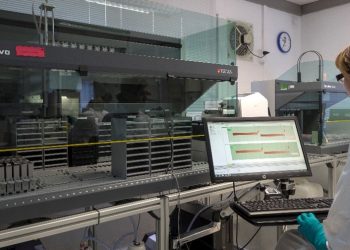With the currently increasing problems of drug-resistance and pressures from consumers to ban drugs from animal feeds, there is a pressing need to move away from chemotherapeutic control of coccidiosis towards vaccination. Most commercially available coccidiosis vaccines contain live oocysts of non-attenuated or attenuated strains of different Eimeria species, with the attenuated commercial vaccines produced using different attenuation methods.
The following video explains the process of attenuation of vaccine strains by precociousness:
As the world’s poultry production continues to grow, so do concerns about the control of Eimeria infections that cause coccidiosis, which remains one of the most commonly reported diseases of chickens.
The ubiquity of chicken Eimeria precludes eradication so the key role in control of the disease is played by hygiene, anticoccidial drugs and vaccines.
Nowadays there is pressing need to move away from chemotherapeutic control of coccidiosis towards vaccination due to different reasons: resistance developed by coccidia to most of the anticoccidial drugs in the market, concerns about drug residues in poultry’s products and strong desires of consumers to ban drugs from animal feeds.
Coccidiosis vaccines basically are divided in: live vaccines and inactivated vaccines, but actually for coccidia there is only one inactivated vaccine in the market and it is registered only in few countries.
Live oocyst vaccines differ in many ways, such as the type of Eimeria species (virulent vs. attenuated), the species composition of the product and the delivery method.
However the major differences among available vaccines is whether the oocysts of Eimeria used are virulent (non-attenuated) or attenuated.
Both types of vaccines contain a certain number of sporulated oocysts for each of the Eimeria species included in the vaccine.
The non-attenuated vaccines comprise parasites that may have been derived from laboratory or field strains, but have not been modified in any way to change their natural virulence.
When chicks are vaccinated with a non-attenuated strain, the initial application is with a relatively low dose of oocysts and should be uniform across the flock.
This strategy of “controlled exposure” allows protective immunity to develop before the contamination of litter with oocysts becomes high.
However, if there is an asynchronous infection within the flock, (due to incorrect vaccine application), some young birds may still ingest large numbers of oocysts leading to clinical disease.
In addition, the non-attenuated vaccine strains, while given controlled doses to minimize pathogenic effects, still undergo the normal replicative cycles in the intestine and cause some degree of tissue damage.
Vaccination may therefore result in a weight gain setback, which is less important for valuable birds with a long life expectancy, such as layers and broiler breeders, but is less justifiable economically for short-lived broilers.
Attenuated vaccines contain oocysts of artificially reduced virulence; this may have been achieved by passaging parasites through embryonated eggs or by selection for precocity based on the work of T. K. Jeffers, “Attenuation of Eimeria Tenella through selection for precociousness“1.
If it is difficult to obtain embryo-adapted parasites with a satisfactory combination of immunogenicity and attenuation of virulence, on the other hand the essential characteristics of attenuated parasites of the precocious type are a reduced prepatent time; a reduced reproductive potential resulting in attenuation of virulence; maintenance of immunogenicity, and genetically controlled stability.
The attenuated strains are selected for precociousness through rapid passages on chickens. Only the first part of excretion of oocysts in the faeces of one group of animals is collected for the inoculation in the subsequent group.
REFERENCES:
 Figure 1: Selection of precocious oocysts.
Figure 1: Selection of precocious oocysts.
 Figure 2: Differences between parental and attenuated strains.
Figure 2: Differences between parental and attenuated strains.
REFERENCES:
- 1Jeffers, T. K. “Attenuation of Eimeria Tenella through Selection for Precociousness.” The Journal of Parasitology 61.6 (1975): 1083-090. Web.



